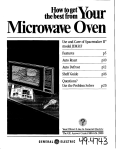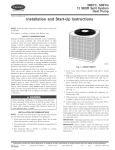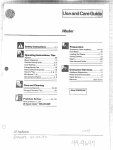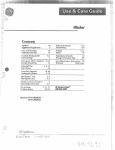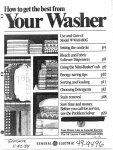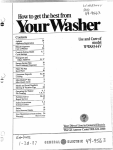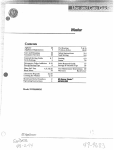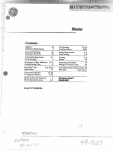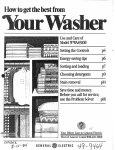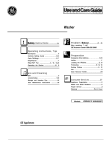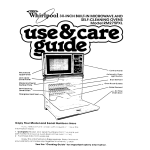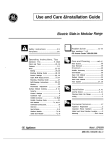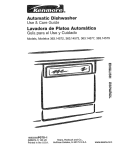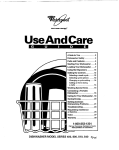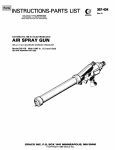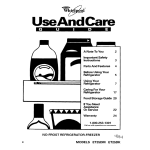Download GE WWA5710M User's Manual
Transcript
bsetitidcki$:etidk~
,,.,,,,,, .’
“f,,
washer
safe~
instructions
....................3. Q
operating
Instructions,
mps
Agitator...........................................................22
ControlsSetting Guide .............................6,7
Cycle Settings..................................................5
Energy-SavingTips.........................................8
Filter-Flo@Pan .............................................4. 8
Operating the Washer ..............................4,5
care
and
cleaning
Limestone Deposits.............................12. 22
Storage & Vacation Tips.............................22
~FO~~@~
~o~w~~.., ................... 18-22
More questions ?...cali
-..
“-:
Pweparatiom
Detergents, Other Additives.............. 11–15
Hard Water ....................................................l4
Loadingthe Washer.,..............................4. 10
Sorting Clothes ...............................................9
Stains ..............................................................l6
Stain Removal Guide...................................l7
~QnSU~~Y
~~YW~C~S ...................23
Appliance Registration..................................2
Model and Serial Numbers ..........................2
Repair Service .................................................2
Warranty ........................................BackCover
Model WA5710M
Readthis book
CarefuIly.
save
time
and money.
It is intended to help you operate
and maintain your new washer
properly.
Keep it handy for answers to your
questions.
If you don’t understand something
or need more help, write (include
your phone number)
Consumer Affairs
GE Appliances
Appliance Park
Louisville, KY 40225
Before yoLlrequest service...
check the Problem Solver section.
It lists causes of major operating
problems that you can correct
yourself.
If you received
a
damagedwasher.
o e
Immediately contact the dealer (or
builder) that sold you the washer.
write
downthe modeland –
serialnumbers.
You’llfind them on a label on the
lower left side near the front.
These numbers are also on the
Consumer Product Ownership
Registration Card that came with
your washer. Before sending in this
card, please write these numbers
here:
ModelNumber
Serial Number
Use these numbers in any
correspondence or service calls
concerning your washer.
obtain a Spanish language
FORYOURSAFETY To
version of this book, call
~
e.J
CTEAnswer Center@
Donotstore
or
800.626.2000
usegasoline
or
consumer information service.
other
flammable Para obtener la versi6n en
de este manual,
vapors
andliquids espafiol
name a
inthevicinity
of
GE Answer Center@,
servicio de informacidn
this
oranyother
para el consumidor,
telefono 800.626.2000.
appliance.
All washiilg instruction terms in this book conform to the Care Labeling
Rule cst:~blishedby the Federal Trade commissio~l, January 1984.
FINALLY, if yoL~rproblem is
,=,
‘,
———
-—-.———..—...-.——
.—
.-.. ..-——.—
————
————
._..—.
.._-—__
I
A
wAmTING—To reduce the risk of
electric shock, or injury to
fire,
persons Wllellusingyour apptiance,
follow basic precaution,
including the following:
this appliance onlyfor
its
intended purpose
* use
as describedin this Use and Care Book.
QDo notwash or dry articlesthat Ilave
washed in, soalkedin,
been cleaned in,
or spottedwithcombustibleor
explosivesubstances(such as wax9
paint, gasoline,degreasers,dry-cleaning
So!ventsykerosene9etc.)whichmayigniteor
explode.Donot add thesesubstancesto the wash
water.Do not use these substancesaround your
+,, e This washermust beproperly
\’Q
~:$ installedand locatedin accordance
+e$,-.
@
withthe InstallationInstructions
beforeit is used. If you did not receive an
InstallationInstructionssheetwithyourwasher,you
can obtain one by contactingthe servicelocation
nearestyou.
—Properlyground to conformwith all
governingcodes and ordinances.Follow details
in InstallationInstructions.
—Instaiior store whereit will not be ex~osed
totemperatures
below freezingor expos;d to
—.
Connectto a properlyrated,protectedand sized
:_—_
-=. powersupplycircuitto avoidelectricaloverload.
—Connectto adequateplumbingand drain
facilitiesas described ii the Installation
Instructions.
QTurn off water faucets when the washer is not in
use to relievepressure on hoses and valves, and to
n~ininlizeleakageif a hose or valve should break
Llrrupture.
L= ~When disconnectingthis appliancepull
‘%x~~!l by the piLIgrather than the cord to avoid
$~>~k~
dan-ia~eIOthe cord or junction of cord
d<
and p?ug.Make sure that the cord is
l~)catedso thiitit wiIl not be stepped on, tripped
~)~’eI”
(II”()[herf$~ise
subjected to clamagcor stress.
washeralltior dryer during Operation.
WARNINWHYDROGEN GAS is
produced by the chemicalaction
within your water heaterand the gas
can accumulatein the water heater and/or water
pipes if hot water has not been used for a period
of two weeks or longer.HYDROGENGAS CAN
BE EXPLOSIVEUNDER THESE
CIRCUMSTANCES.so to preventthe
possibi~ityof damageor in,~ury,if YOUhave not
two Weiks
tiore9or move
used hot water for
into a residencein which the hot water svsteRn
may not have been used for some timeythrn on
all hot water faucets and allowthem to run for
severallninutes before using any electrical
appliancewIlichis connectedto the hot water
system. This wiIlallow any hydrogengas to
escape. Since the gas is ~ammable9do not
smoke or klsean open flame or appliance
tir
during this process.
*Keepall laundryaids (such as
[0 [ detergents,bleaches,fabtic softeners,
etc.) out of the reach of children,
preferablyin a lockedcabinet.Observe
%
all warningson containerlabelsto avoid
personalinjury.
~Keep the area aroundand underneath
yourappliancesfree from the
+
‘>%accumulationof combustiblematerials,
=
such as lint, paper,rags, chernicds, etc.
~Keep the floor aroundyour appliancesclean and
dry to reduce the possibilityof slipping.
~To finfize the possibilityof electric
shock, unplugthis appliancesfrom the
3 “J ‘ power supplybefore attemptingany
maintenanceor cleaning(exceptthe
rern~valand cleaningof the lint filter),
/*%
NOTE: Turning the Cycle Selector
‘ knob to an OW position does NOT
disconnect the appliance from the
s Do not operatethis applianceif it is damaged,
malfunctioning,partiaIiydisassembled,or has
missingor b~okenparts, inc~udinga damagedcord
or plug.
e Never climb on or standon the washertop.
*Do not wash fiberglassarticlesin your washer.
Skin irritationcould resultfrom the remaining
particlesthat may be picked up by clothingduring
subsequentwasheruse.
~The laundryprocesscan reducethe
flame retardancyof fabrics.To avoid
such a result, the garment
manufacturer’scare instructionsshould
be followedvery carefully.
For washer operation
~Do not leave washer lid up duringcycle.This will
stop the wash and spin actionand prevent
completionof the cycle.
&
HowTO OPEMTE
Yom c~o~ms
wAsmR
WARNING—TO reduce the risk of
fire,
e~ectrie
shock, or injury to persons when using your
appIiance9 read the IMPORTANT
SAFETY msTRucTIoNs
before operating
this appliance.
HoQvyDuty L?rge Cepacify
{
‘-”~
.. :
@ -%7
Oif~
❑ e
I
Pemniiefit
soak Cvclo &
ra
I
Regular Cyctos
R
In
FiveCycleWasher
u
WASIIJUIKSE
Tempernfure
Pormononf Press b$lth Cool Dotsn
@@
II
FlORt,tAl
LllillTSOll
h
NOTE: Do not use the Filter-Flo pan as a lvash
basket. Do not put any items to be washed in the
Filter-Flopan.
For informationon how to use bleachand fabric
softeners,see Other LaundryProductssection.
~Close the lid. Washerwill fill but not agitateor spin
.
with the lid open.
Use the Controls Setting Guide to help you make the
proper selections.
0 Push Cycle Selector knob in and turn clockwise to
your selected wash setting.
@ Pull Cycle Selector knob
*START
,
out to start the washer, If you
.,
v\
wish to change setting after
washer has started, push
STOP d
Cycle Selector knob into
F
stop the washer and reset to
~
the new position. Setting can be changed at any time.
@ Select Water Level.
SMALL: Washer is less than one-half full of clothes.
MEDIUM:Betweenone-halfand two-thirdsfull.
LARGE: Over two-thirds full.
@ Select Wash/Rinse Temperature.
-Tips
toIIeIpYouselect settings
Provides
longer
wash time
for most
cottons,
linens,
I
work and
play ciothes.
uGHr SOIL
For
permanent
press and
delicates.
An
extended
cool-down
spray rinse is provided to minimize
the setting of wrinkles.
Non
Use with
most
soaking
aids to
loosen
embedded
soi~sand
stains.
—
Vlhat Happens inEach setting
(ApproximateMinutes)
Regular
Permanent
Press
cycle
Normal
selector
settings
wash
. S*
—
—.
Flinse
———
5‘pin
15
3’/2
6
3’/2
3 ‘/2
3’/2
7
~~
I
IT
To’iE#l
Ti:l]e
Light
Soil
31
Soak
cycle
Normal
Soil
Light
70
4
—.
3’/2
2’/2
2’/2
3’/z
3’/z
7
11
d’iz
22’/2
4’/2
16’/2
[-~
_
,———...
—-..—
_,______
———
.J‘1
r
,—”
—_,__
._”___
-—---......-—.
CONTROLSs~~~m~ GumE
controls setting
Guide
for
different
fabricsandloads
—
I
Load
wash water
Temperature
cycle setting
Cottons and Linens
White/Colorfast
Bright/Noncolorfast
Hot or Warm
Warm or Cold
Regular Cycles
Regular Cycles
Normal Soil Setting
Normal or Light Soil
Setting
——.
Work Ciothes
Heavy soil
Average soil
Hot
Hot or Warm
Regular Cycles
Regular Cycles
Normal Soil for smali loads; Heavy for all other
Normal Soil Setting
Permanent Press, Treated Cottons,
Blends with Cottons
Heavy or oily soil
Average or light soil
Hot
Warm
Permanent Press Cycles
Permanent Press Cycles
Normal Soil Setting
I.ight Setting
Synthetics—Po]yester, Nylon,
Acrylic Knits and Woven Fabrics
Sturdy
Delicates
Warm
Warm
Permanent Press Cycles
Permanent Press Cycles
Normal Soil Setting
Light Setting
Warm
Permanent Press Cycles
Light Setting
Warm
Permanent Press Cycles
Light Setting
Permanent Press Cycles
Normal Soil Setting
Silks, Wools; Blends of Silk
and Wool
Rayon and Acetate
-——
8
Down-filled garments, if machine
washing is recommended
—
—
Baby Clothes—Sturdy, such as
Diapers. Nightgowns, Shirts, Pads,
Sheets, Receiving Blankets,
Coverdils
Regular Cycles
Normal Soil or Light Setting, depending
on amount of soil
Baby CIothes-Delica[e
Permanent Press Cycles
Light Setting
BlankeLs-Wool, Par[-Wool, Cotton
Regular Cycles
Light Setting
Regular Cycles
Light Setting
Bl:]nkcts—Syr]ll)etic, Electric
——.
Warm
—______
1
Hot or Warm
Hot or Wclrm
Permanent Press Cycles
1
~ Permanent Press Cycles
Iiot or Warm
Cold or Warm
Light Setting
—.
Regular Cycles
Normal Soil Setting
1
[ Regular Cycles
.
Normal Soil Setting
1
~7\’arnl
Permanent Press Cycles
j
i
\~/arm
Permanent Press Cycles
Normal or Light Setting, depending orI -+,
amount of soil.
(.;’)
-,(“z
—.....-..-.-.....——..
k
—————
-----..—
——-
-..—-—
. .....,..e._-—....
— .—.-.
———...
-”——.
-.--.
_---.
_-
—_-___,
_-.
_.
—
–—
‘ -“’ Refer to
Garment
Manufacturers’care
Labels
Bleach
special InstruetiolRs
Liquid chlorine type.
Only non-chlorine bleach when needed,
If colorfast is unusually soiled, use hot water. Use maximum detergent recommended in
the Hard Water Guide.
White or colorfast, liquid chlorine type.
Non colorfast, only non-chlorine bleach
when needed.
Use maximum detergent recommended in the Hard Water Guide.
White or colorfast, liquid chlorine type.
Non colorfast, only non-chlorine bleach
when needed.
Small loads reduce wrinkling, Use maximum detergent recommended in the Detergent
Guide.
White or colorfast, liquid chlorine type.
Non colorfast, only non-chlorine bleach
when needed.
If unusually soiled, use hot water. Use maximum detergent recommended in the Detergent
Guide. Small loads reduce wrinkling.
No bleach
Wash or?l))if recommended by the garment manufacturer. Follow instructions carefully.
‘Seldom needed, If needed, use only
non-chlorine bleach.
Wash in your washer only if recommended by the garment manufacturer.
No bleach
Wash frequently to fluff up the down and retain the garment’s warmth. Wash separately. Wet
down gives off an odor which may be absorbed by other garments. Odor disappears when
garment is dry. Treat heavily soiled areas with liquid detergent or paste made of water and
granular detergent. Close zippers. Wash 2 or 3 at a time or add towels to balance.
GARMENT MUST BE TUMBLE DRIED,
White or colorfast, liquid chlorine,type.
You may prefer to use a mild type detergent. Do baby clothes separately. Pretreat spots,
Rinse diapers, nightgowns, pads and sheets after use. Keep diapers in a covered pail of cold
water and conditioning agent like Borateem brand.
Only non-chlorine bleach when needed,
You may prefer to use a mild type detergent. Do hand-knit garments by hand.
No blC;lCh
Fill washer, add detergent. allow to dissolve before adding blanket. Do one blanket at a time.
Pretreat heavily soiled spots with liquid detergent.
No blctich
On electric blanket, scw a strong piece of cloth over plug to protect blanket and washer from
damage. Do one blanket ai a time. Pretreat heavily soiled spots with liquid detel:ent.
White or cr)iorfas(. li(Iliid~’hlorinctype.
u lCUIII1l(lLI[ ]oOSCdirt
Whi[c or colorfast.”lic]llidchlorine [ype.
1
Whitr or c{)lorlilst,Ii(]uidchlorine (ypc.
N() blc:lch
hcforc washing.
\~;lSh oll]~ ~ (lr .; rL!gs or I1lll[s ~1[onc [iInc. Silake before washing [o remove cxcess dirt,
For ncw “in(ii:c) bllie’”.jcalls, wash at least 3 times in very small loads with full water fill.
ample
room
(o move to avoid white lines at creases. May discolor plastic wasllcr
i par[s. Subsc(]llen[~vashingswill redtlce discolorations, but will probably never eliminate it.
1 The st:~inedl)~]rts~villnot discolor sut~sequentwashing loads.
!
~t~i)[~s need
HOW To USE Tm
“ “SOAK
CYCLE”
temperaturewill
automaticallybe
cold.
If a hot or warm
-
SOAKCYCLE
—
Cycles. Start the washer. After washer fills
HR~V
DurjI Ln~e
Cnpaci@
Regular Cycles
complete the cycle.
6For an extended soak, allow the washer to f~lland
~
e
soakis desired,set
theWAS~INSE
TEMPERATURE
“-=-----
to
o
SoSkor).
and beg~ns
to agitate, push in the Cycle Selector Knob and turn to
“SQAI<CYCLE.” Pull out the Cycle Selector Kmob
Uallr
SOIL
NOEMA1
switch to
“~~T/COLD’” or “WA~/COLD” and turn the
Cycle Selector Knob to “Normal” in the Regular
HowTo USE Tm
The Filter-Flo pan
is the lint filter.
Position the
Filter-Flo pan on
the agitator after
loading clothes into
the washer. Lint is
easily seen and
removed after the
wash is finished.
agitatefora fewminutesto dissolvethe soakingagent.
Thenpushin theCycleSelectorKnobto stopthe
washer (keep lid closed)and allow to soak for as long
as desired.After desired soak period, pull out tie Cycle
Selector Knob to complete the cycle.
F~TER~FLO@
PAN
-
NOTE: Do not use the Filter-Flo pan as a wash
basket. Do not put items to be washed in the Filter-Ho
pan. Do not place detergent paeketi in the FiIter-FIo
pan.
._—__
,..
-—-
EmRGY=sAm~ Tms
If your clothes and household
items don‘t 1ookclean and fresh
after washing, you will probably
re-wash them..and that means
you’ll waste energy. Remember to
sort your clothes carefully, and
load them properly, select correct
cycies, Llseenough detergent and
Ciloo.sc
a IVaterre?n~lej”arlire
Vvar})l
Cnol!glz to release a}ldgel rid of
,S(li[.
~Use Hot Wash—upto 150°F.—on
a regl~larbasis only when washing
heavily soiled articles-such as
work and play clothes.
*Under normal soil conditions,
wash in water above 80°F.(27°C.).
This generally means using the
W<armWash temperaturesetting
on your washer—temperat~es
approximatey 90°F.to 11O°F.or
hand comfortable.If you noticethat
soil has accumulatedafter several
consecutivewashings,use Hot Wash
occasionally,if safe for fabrics.
~Try to wash less often. Save
articles of the same type of fabric
until you have a full load.
~If you must wash smaller loads,
adjust the amount of water. Small
loads should have lower water
levels.
~Washin off-peakutilityhours.
Yourlocal utilitycan tell you
whichare the off-peakhours.
I
,,
i
1!
.%
>=
,.
,1- ~
L.
.._..
_. - . . ..___
A—_____________________ —.
—..—
__ ~—
..—”...-.
.
.
.
texture
PRODUCERS—suchas terry toweling and
chenille—giveup lint.
LINT COLLECTORS—such as man-made fibers and
napped fabrics like velveteen and corduroy—attract
lint, These must be washed separately.
LINT
separate
ro
Wormore informationon lintcontrol,seeThe
section.
Problemsolver
sortby fabric
t
Separate
ro
~ Delicates m
rorn ~L
ro
Ld
A
by soil
sort
-.
u
In additionto sorting
to reducelintcollection,
it is recommended
thatfabricsof similar
constructionbe washed
togetherwhenever
possible.
-—--- Separate
.-—-
It pays
to Checlcand
prepare
clothes for Washing.
QEmpty pockets, brush out cuffs,
zip zip13ers,snap snaps, hooks
and buttons.
~I)(Jarly necessary
Itlcflclin,Q-ri?3s,hems, tears.
soaking and PretreatiIlg—a
good $Va’y
to loosendeep soils
NORINFOWTION ON
SOAI<INGAGENTS9 see Other
and Stains.
A thorough soaking with detergent
or special soaking agent is another
way to remove heavy soils,
embedded dirt and even some
stains.
Soaking can be either a completely
sep:lrate washing step or a
prelimi]l:]rys[ep to a complete
W/aSIl cycle.
For detailed
Laundry Products Guide.
0 Pretreat heavy soil by rubbin~
in a small amount of liquid detergent or a paste made of water
and powdered detergent or soap.
For best results,
before washing.
(rj )
.—
—-- —.. —
—-—.
.—....—-
—-.___
-; ,
.
..—._.__..”
/~
. .
.
.
. .
..
—..___-...--.._”__
.,,
. ..—
This illustration,with clothesjust
reaching the Clothes Retaining
Ring, shows a proper load. Clothes
have ample room to move because
they are not packed down, nor
wrapped around the agitator.
Clothes are loaded dry since wet
items are apt to pack down which
encourages overloading. This size
load requires a full water fill.
What is the best sizeloadof
.—
—
Load clothes dry.
*Take a properly sorted group of
clothes and drop them loosely in
the wash basket in this order:
@ Large Items-1ike sheets, Do
not wrap around the agitator.
@ Small Items—like
washcloths.
e Medium Size Items–like
towels.
Here is a typical full load:
3 Double Sheets
4 Long Sleeve Shirts
3 Boxer Shorts
6 Standard Pillow Cases
5 T-shirts
2 Pair Trousers
3 Handkerchiefs
o
clothes—large,medium,or
small?Savetime,energyand
detergentby avoiding extra use of
the washer.Try to wash a full load
of clothes. If you can it is better to
save clothes until you have a full
1oad.If you must wash smaller
loads, save water, energy and
detergent by adjusting the water
level for the size of the load. See
Operating section.
.—.-
Toadd items
after
the }Vasherhas stirtede
~ TLIrn off the washer.
0 Carefully remove the Filter-Flo
pan.
oAdd any additional articles by
submerging them next to the
agitator.
QReplace the Filter-Flo pan and
restart the washer.
NOTE: Do not use the Filter-Flo
pan as a wash basket. Do not put
any items to be washed in the
Filter-Flo pan, Do not place
detergent packets in the Filter-Flo
Dan.
.
NOTE: When washing stockings, “--—panty hose and other easily tan;led
items, always handle separately. To
minimize tangling, we recommend
the use of a net laund~~~
bag.
.
ti.
special recommendationsfor
washing permanent
press if you do not
have a dryer.
lf you are Ill:lcllille-wasilingPern]anent Press clothes
that you p]an to line (h-yor drip-dry, use extra care to
nlinirnize wrinkling in the wash process:
* BC Ctil”CfLllnotto overloadwasher. ~ern]anen~
~~ess
clothes must have ainp~eroom to move freely. A
Medium size Permanent Press load is the I.argestthat
Shoulclbe washed.
~Use more water than you would for a regular load.
Use a Medium Water Level for a Small Load; a Large
Water Level for a Medium Load.
QRemove clothes promptly as soon as washer stops
and hang immediately.
~To minimize wrinkling, use the Gentle Wash/Spin
Speed.
i
\
-—
--.-..,.,—..—
.,-
——.
—
r..
-..,,_,..
-._--’
p~oducts
Advantages
Disadvantages
Phosphate-
Perform well in hard or soft water.
Are not available in some areas.
Polvdered Detergents
Wash all types of fabrics well.
Can be used in hot, warm, or
cold water.
Non-PhosphatePowdered Detergenk
Perform satisfactorily in soft
or moderately hard water.
Generally do not clean well in
hard water.
In some areas only non-phosphate
products are available.
May be difficult to dissolve,
especially in cold water.
Should not be used in cold water.
Those containing sodium
carbonate as an ingredient may
cause harmful limestone deposits
on clothes and washer when
combined with hard water.
(See Detergents section.)
-—-
Liquid Detergents
Perform well in soft water.
Offer better performance in
hard water than powdered
non-phosphate types.
May not perform as well as
powdered phosphate products
when diluted in wash water.
Clean synthetics and fabric
blends well.
Are excellent as concentrates
for removing spots.
Completely dissolve even in
cold water.
Perform well in soft water.
Generally do not clean well in
medium-hard or hard water.
May combine with water
hardness minerals to form
stic]cysoap curd.
-.-..
.—,.
...-.
.”———-———.
” . ... .
. . .. .
,,.
-—.———..
_..———___,,.....” — ------——. -.——-—
——.—
-—-—...
_,
I
-.
WSmTS OF CONT-D
IJSE OF CAWONATE DETERGENTS
—
—–
Is your water hard? If it is, and if you use a carbonatetype non-phosphatedetergent,you will most probably notice
limestone*depositson your clothes and washer surfaces.The hardnessof your water and your washing frequency
will determine how rapidly the limestonewill build up. If your water is VERY HARD (11or more grains) and if you,
washjust a few loads a week, you may see limestonebuildups in just a few months.
Although limestone buildup occurs more rapidly on
cotton, it will eventually affect various fabrics in the
following ways:
e Gives a stiff, harsh, rough feel to fabrics such as
toweling.
g Causes colors to fade and become dull and dingy.
~Causes graying of fabrics.
e Leaves a white, powdery residue on dark-colored
iterns.
e Causes spot-fading of bright colors as a result of
direct contact with detergent.
~Reduces wrinHe-resistance of permanent press
fabrics.
a Destroys effectiveness of flame-retardant finishes on
cottons such as children’s sleepwear.
~Increases fabric wear because of the scrubbing action
between limestone deposits on the fabrics during
washer agitation.
Effecti on washer
Recommendedmethods to
reduce
limestonebuildups
~Unsightly buildup on all washer surfaces exposed to
the wash solution.
~Mat-like>crusty formations caused by lint adhering to
the sticky limestone deposits.
~Increased service calls because of limestone deposits
in the pump, recirculation water hoses, filters and other
washer parts.
@Reduced useful life of washer.
-.-
~Use a powdered phosphate detergent or a liquid
detergent if these are available in your area.
~Install a home water softener. This will significantly
reduce limestone buildup.
gUse a packaged non-precipitating water softener,
such as Calgon brand with phosphate.
:- “
..
Good V+ashingpractices
may de!aylimestone damage to
Clothes
‘fhc following recommenciotionswill temporarily delay
tflccf’fcctsof limestoneon your clothes. These are
gel]eraliygoociwashing practices and will give better
soi] rcnlovai whether or not yoLlhave hard water or use
carbonate detergent.
QUsc l~o[terwash water. for example Lipto 150°F.for
cottons. This also inlprovesoily-soil removal.
QIncrease amount of detergent.See guide on opposite
page for recommended detergentamounts in relation to
water hardness,
~Increase use of bleaches, presoaks, packaged water
conditioners,prewash soil and stain removers to help in
removing stubborn soils and stains.
QUse greater care in sorting loads, Wash very dirty loads
separately and increase detergent to help keep dirt fron~
redepositing on Iess soiled items. Wash delicate items
separately to prevent damage from heavy, sturdy clothes.
oWash smaller loads to increase cleaning actio]~of
(’-”)
washer.
~-.,_j{
* Usc fabric softener to counteract stifi]ess or harsilk~css /,._
,/’
in clothes.
t\
,,=-.
l?
. .:.
”,
_——__
., ..____
. . . . .._..
._
.—----
. . .+.
_
——..,-.-—
-————
--
--”
.
..
.
..——
.—._.—_
—=..
-AL_________
.—.—...
.
——.
Onceclotheshave developeddeposits,they may be
partiallyrestoredby soakingin a solutionof two cups of
vinegarin one gallonof hot tap water for 15minutes.
USEA PLASTICCO~mR.
Then wash clothesin
the washerusing detergent.
.-
CAUTIONS:
e Do not use vinegarsoak solutionin washer.
The acidicactionof the vinegarmay damagethe
porcelain.
@Vinegarsoak solutionmay reducethe
writie-resistance of permanentpress fabrics.
e Vinegarsoak may darnagethe dyes in some fabrics
HOW WCH DETERGENT SHOmD YOU USE?
The use of a sufficient amount of detergent is one of the most
important things you can do to make sire your wash comes out clean.
Amount requiredvaries
according to:
1. Water hardness
Amount of soil
I
.–—’
4. Type of detergent
5. Wash temperature
Usemoredetergentif you
lkave..
●
1. Hard water
2. Large 1oacis
3. Greasy or oily soils
If the recommended amount of
detergent produces too many suds,
switch to a low sudsing detergent
brand, and follow instructions on
package.
Using too little
detergent is a
~
common cause of
laundry problems.
Always measure
~
U
detergent in a
standard measuring cup.
How to use detergent—
granular or powdered:
For best results, add detergent to
the wash basket before loading
clothes. If you load your clothes
first, add detergent next to the
agitator,
If your detergent doesn’t dissolve
well, predissolve the detergent in
hot water, then pour directly into
the wash basket.
4. Lowerwash~emperature
5. Lowphosphatedetergent
Recommendedamount
ofdetergent for
averagesoil load
I
I
l— —
water
Level Setting
water
Elardness
Larce
Medium
Small
1. Use recommended amount of
detergent for your load and water
hardness as shown in guide.
2. When using other detergent
types—low and no~lnalsuds,
powders, liquids,non-phosphate
powders—follow recommendations
on package.
3. For hard water treatment, see
Hard Water Guide.
Ii ~.>,
i,
.,
.2,’
Before you can decide what to do about hard
water, you need to know if you have it and, if so,
how hard it is.
oIf you live in a municipalarea, contact your
county agent.
~If you live in a rural area, or in some suburban areas,
contact your county agent.
The answer will be “you have ‘so many grains’ per
ga]]on” and means this:
Oto 3 grainsper gallon—SOFT
If you water is SOFT, you have no problem. You can
use soap or detergentas you prefer and forget all
about hard water. If you have HARD water—lessthan
10 grains—andyou use phosphatedetergent, you also
have no problem.
But, if you have more than 10 grains, you will need to
soften your water with either...
—
1. An installedwatersoftenerin yourhome,or
2. The use of a packaged water softener.
For informationon water softeners,see
Guide below.
4 to 10grains—HARD
11 to 19 grains—VERYHARD
20 grains and over—EXTREMELY HARD
Add this much water
softener with a full water
level
Grains of
hardness
o-1o
10-15
15—20
20—25
25—30
over 30
I
1 cup plus 1 tablespoon for every 5 grains above
30 (240 ml plus 15 ml for each extra 5 grains)
1Xcups plus 1 tablespoon for every 5 grains
above 30 (300 ml plus 15ml for each extra 5 grains)
-.-—
-..-..
..”.—
----------
..
. .
--
,..
_.,
_..+
.
-.-—-——..—.
__.
”_
P.e*
‘-=._
Q..... ......... ......=______________
___
_...
.—.. -—— .......
product and type
How to useit
BLEACH
chlorine Liquid
such as Clorox brand
Dilute bleach with at least one quart
(0.96 liter) water and add after wash
action has started and detergent is
dissolved.
Non-chlorine such as
Clorox 2 brand
Follow package directions.
Put bleach into washer with detergent.
FABWC SOFTENERS
Rinse additive such as
Downy Brand
Mix recommended amount with one
cup (240 ml) water and add at start of
rinse cycle.
Wash Additive such as
Rain Barrel brand
Follow Package directions.
Add during wash cycle.
SANITIZER
Chlorine Bleach,
such as Clorox brand
_
=----
“ ““” WATER SOFTENER
Non-precipitating
such as Calgon brand
Such as Biz brand
PRETREATING, STAIN
AND SPOT REMOVERS
Such as Spray’n Wash
and K2R brands
‘IINTS AND DYES
PcJwdcrcdsuch as Ri[
ilIl(.1 ~in[e,x
hI’itn(JS
I
1) Do not pour undiluted liquid chlorine bleach directly into
washer or on dry clothes,
Z) Some of today’s washable fabrics should not be chlorine
bleached such as: 100%cotton flame-retardant children’s
sleepwear, silk, wool, mohair, spandex, leather, or non-fast
colors. Dilute bleach before using on any fabric.
3) Check Manufacturers’ Care Labels for special
instructions.
1) Maybe used on all kinds of fabrics,
2) Is most effective in hot water.
1) Helps make clothes fluffy and soft.
2) Reduces static electricity.
3) Use carefully. Too much may cause staining on
some clothes.
4) Do not pour directly on clothes.
5) For those recommended for adding to the wash cycle,
such as Rain Barrel brand, follow manufacturer’s
instructions exactly.
Use in case of infection and
contagious disease.
See under Bleach above.
Guards against infection by killing most bacteria and
viruses.
Follow package directions.
Add at start of wash cycle.
?O11OW
package directions.
~se with detergent or soap in wash cycle.
Suspends hardness minerals in solution, keeping
water clear,
Combines with water hardness minerals to forin precipitate
which gives cloudy or milky appearance to water.
I Follow package directions.
-,
Follow package directions. Treat only
heavily soiled areas, Check garments’
care labels for instructions.
CAUTION: Washer control panels and finishes may be
damaged by some laundry pretreatment soil and stain
remover products if such products are sprayed on or have
direct contact with the washer. Apply these pretreatment
prodt]cts away from washer, The fabric may then be washed
normally, Damage to your washer caused by pretreatment
products is not covered by your warranty.
Follow package directions.
NOTE: Tinted garments may not be
colorfidst.Wash separately.
Clean washer to avoid discoloration of next load. Go
through comple[c cycle (5-nlinute wash) using hot water,
1/2 cup (120 ml) detergent, 1 cup (240 ml) bleach. Wipe
exterior parts. Caution: Tinting may discolor plastic in
ivasher. Subsequent washings will reduce discolortition
but may never eliminate it.
.—
ow sTAms
1.
Tryto remove stains as soon as possible. The
fresher the stain, the easier it is to remove.
2, Before attempting to remove any stain, take
these steps:
~Find the fabric and the finish in the chart on the
next page, and use only recommended methods,
e Check the care label instructions that came with
the garment.
—
~Test stainremovalproduct on a hidde~~inside seam
or on a sample of the material.
~Avoid use of hot water on unknown stain. It can set
some stains.
3. Follow stain removal with a thorough rinsing.
4. Wash with recommended amount of soap or
detergent.
—
cup (60 ml) chlorine bleach with one gallon (3.8 liter) of cool
water—approximately80°F. (27°C.)—in a sink or pan. Soak stained area
for 5 minutes and launder in washer.
Mix 1/4
The case
ofthe 6’Intisible’9stain
If these stainsare not completelyremoved in the wash,
the oily spots may pick up dirt from the wash water.
Then they will become very visibleand you may thi.
they were caused by the wash cycle itself.
Food or cooking oils on your syntheticgarments may
cause stains which are virtually invisible and which
you may not notice as you put your clothes into the
washer.
.K
“---
oncethese spo~ become visibIe9how Can you removethem?
~Rub in undiluted liquid detergent and let stand 30 minutes.
@Re-wash using hottest water the fabric can stand.
How can yo~~prevent
these “After-You-Wash”S@i~S?
~ Incrcasc [he amount of detergent normally used.
~ lncrcasc water ten]perature where fabric will permit.
QWash synthetic garments more often.
; .-.
.%,
:!_,
---
—
----
—-”-.--.
-—.-.-..
. _________
.
.
—
—=...—.
,—.-.
. .
.
.
.
.
.
.
.
.
.
white and Bleachabie Fabrics
other washable Fabrics
See Control Setting Guide,
}.dhesives
(ChewingGum, etc.)
Rub with ice or immerse in very cold water. Use dull tool to
cat-ef[(i!y scrape q~c[s JrrL(ch (idltesi~~e
or gUIIIas possible. Sponge
with a safe dry cleaning f~uid,* then launder.
Same as white and bleachable fabrics.
Antiperspirants,
Deodorants
Apply undiluted liquid detergent. Rinse. If stain remains, bleach
according to Stain Removal Hint on opposite page. If color has
changed, you may be able to restore it by sponging with
ammonia,** Rinse thoroughly,
Same as white and bleachable fabrics
except use non-chlorinebleach.
Blood
Soak in cold water, then launder in warm water. If stain remains,
bleach accordingto Stain RemovalHint on oppositepage, launder.
Sponge or soak in cool water, then
launder.
Chocolate, Cream,
Ice Cream and Milk
Soak in cold water. Treat stain with a safe dry cleaning fluid*;
Apply undiluted liquid detergent, launder, dry. Bleach according
to Stain Removal Hint on opposite page, launder and dry.
Soak in cold water. Sponge with a safe
cleaning fluid.* Apply undiluted liquid
detergent. Launder in warm water.
Coffee and Tea
Without cream: Bleach according to Stain Removal Hint on
opposite page. Launder. With cream: Follow guide directions for
cream.
Spongewith warm water.If stain remains,
apply warm glycerine, let stand 30
minutes and rinse well, or sponge with a
safe dry cleaning fluid.* Launder,
Cosmetics: Eye Shadow,
Lipstick. Mascara, Liquid
or Pancake Makeup. Rou.~
Powder; Crayon: Grease,il, Tar, Cod Liver Oil
Treat stain with safe dry cleaning fluid.* Apply undiluted liquid
detergent; launder and dry. Bleach according to Stain Removal
Hint on opposite page,
Sponge with a safe dry cleaning fluid,*
Then launder in warm detergent water.
Fresh Frui(, Fruit Juices,
Wine.Vegetablesor Food
coloring
Soak stain in cool water. If stain remains, bleach according to
Stain RemovalHint on oppositepage, !aunder.
Spongewith warmwater.Bleachremaining
stain with non-chlorinebleach.
Gr~ss,Foliage,Flowers,
31ildew,Scorch
Apply undilutedliquiddetergent.Launder.(Treat mildew spots
fresh, before mold has a chance to weaken fabric.)
If either type stain remains, bleach accordingto Stain Removal Hint
:Jnoppositepage, launder.(Severe scorch cannot be removed.)
Spongewith warm water.Applyloldil~lred
liqz(iddetergent.Bleach remainingstain
with non-chlorinebleach, then launder.
Old mildew stains can seldom be
removed. Scorch can seldom
be removed.
Il]k,Balipoin[
jrcsh stains: Placses(ain face down on an absorbent towel and
I[3011~c
Withdry c]canin~ fluid,;+or usc spray cleaner. Apply
]n~iju[eLl
liquidLle[er:enl.
Oldstains:bleach accordingtoStain
Same as white and bleachable fabrics
except launder usingnon-chlorinebleach.
ii~iicn
with (>il.lard or Vaseline, then sponge with turpentine or
Same as white and bleachable fabrics.
<cnl(~~IL~l
l-iintol~oppositepage.
f’iliilt illlli Varnish
IiIn:IIIa
}Jcrspir:llion
oi 1.
Lallndcr in u’arm lvatc!r.
.—.—c—
kppiyu[ldilu[ed liquid detergent :Ind launder in warm water, If
,}l{~r
hitsdh;lngedy(JL]i])ii~ hL’ ;Iblc
toI“cstol”cit by treating with
illlllllo[li:l
01” )Iincg;ir.
‘“ ; 11”il[l~
s[ain
remains.
clc;llliiljj ll!]id: (~i hlcach :lcc(~rdin~ (o
()])ll{~si[c
p:]~:c,lii(I;ILILIr
/\pplj’
aIId
treat
v;i[tl
safe
Launderin warm water,Rinsewell,Bleach
with non-chlorinebleach,
dry
Stain l<cmovalHint on
LII).
l-tlst rL’nlo\’cr, ‘“ using []lL]fl\l(~l~[L[[”~r’Sdir~~[i~lls. Rinse ~Ild
Same as white and bleachablefabfics.
P:..-.
-, ‘.=..
—..— --—
.———.
.——.——
!/ j~
--- —-. .-_. _,.-,-- ..____
—
. . . ..——...—
—-
——-..... .———.
.’..
. . . . .-
PROBLEM
POSSIBLE CAUSE
LINT OR RESIDUE
ON CLOTHES
0Incorrect sorting of clothes. Separate lint producers (such as terry towels and chenille)
from lint receivers (such as man made fabrics, velveteen, corduroy).
9Washingtoo long, especiallyfor smaller loads. For normal soil, wash one rninute per
pound of dry clothes.
o Use of non-phosphatedetergentswhich combine with hardness minerals to form a
precipitate which can be mistaken for lint. Use a phosphate or liquid detergent; use
warmer wash water or soften water with an installed mechanical softener or a packaged
water softener.
~Powdery residue from granular detergent may appear to be lint. Predissolve granular
detergent in hot water before adding to washer; make sure detergent is completely
dissolved before adding clothes; switch to liquid or cold water detergent or warmer
wash water. See Detergent Guide.
* Overloading will cause abrasion which creates excessive lint. Wash fewer items with
correct water level.
~Too much bleach. Use correct amount of bleach according to package directions.
I
I
I 0 Not enough detergent
I
GREASY OR OILY
STAINSON
LAUNDERED
GARMENr~S
to hold lint in suspension
during wash cycle. increase
amount of detergent. See Detergent Guide.
.
0 Incorrect use of fabric softener.If used in wash cycle, softeners may react with
detergent to create a white deposit. Use softeners in rinse cycle only unless package
-ti~~. :specifies adding to wash cycle. See Other Laundry Products section.
o~&y-~ Pillingusually on polyester-cottonblends is caused by normal wear and may look like ~ ‘-lint. Turning clothes inside-out may provide some help.
~Static electricity caused by overdying will cause attraction. Use fabric softener in
rinse cycle,
I
I
These are sometimes called “InvisibleStains”because you may not notice them before
washing clothes. However, if oily soils are not completely removed in wash cycle, the
oily spots may pick up dirt from the wash water.The spots will then be vely visible.T’hey
are }zotcaused by the washer.Wash syntheticgarments as soon as possible after we~aring.
Use more detergentthan normal and hottest water fabric can stand. If spots appear, rub in
undiluted liquid detergent, let stand 30 minutes and rewash with extra dete~gentusing
hottest water fabric can stand.
* IJISUfficientdetergent. You may need to increase amount of detergent used if load is
larger than noilnal, if soils are oily or heavier than average, if water level is large or if
water is Hard to Extremely Hard.
~Water not hot enough for type of ~oad.Be sure water heater is set to deliver hot water at
the washer at 140°- 150°F.Do not wash when othel”hot water needs—such as
dishwilshingor family baths-—archeavy.
oPoor or iI~~’eriordetergent.Change to phosphate detergent, if possible. Follow these steps:
1. Use water conditioner, (st~chas Ca]gon brand)
‘) Pretreat
-.
St:liils
.,
.
—
—
I
PROBLEM
GRAYEDCLOTHES
(continued)
CLOTHES
POSSIBLECAUSE
~Improper soaking with insufficientdetergent.V’suallya 30-ltinute soak is sufficient.
However, when using extended soaks for heavily soiled garments, you may need to use
twice the recommended amount of detergent.
oUse of soap in hard water. Switch to a phosphatedetergent,or follow six steps in the
Problem Solver in this section.
~Washingtoo long may result in increased soil deposition.Use shorter wash times for
smaller loads.
~Detergent dissolves too slowly.Detergent must be present in the wash solutionat the
start of agitation. See Detergent, Other Additives section.
e To restore grayed clothes, follow one of these procedures:
1. Put clothes in washer. Fill with HOT water. Check Manufacturer’s Care Labels to
determine if hot water is suitablefor garment.
@Add a non-precipitatingtype of water softener such as Calgon with phosphate—
use 2X times as much as you need for normal water softening.
~Do not use detergent or soap.
e Allow clothes to go through complete cycle.
~Repeat, if necessary.
2. If you prefer to use the Soak Setting, see How to Use the Soak Cycle section.
Use the water softener in place of soak agent or prewash detergent and allow clothes
to soak for about 20 minutes.
~Incomplete removal of body soil due to constant use of insufficient detergent. Check
hem of T-shirt or pillow case. If they are white and center is yellow, it contains body
oil. Restore whiteness following procedures on “Grayed Clothes,” above.
~Chlorine bleach may yellow some fabrics with resin finishes.Use oxygen bleach
(such as Clorox 2 brand). Refer to Garment Manufacturer’s Care Instructions. Restore
uolorusing color remover (such as Rit or Tintex brands), following package directions.
‘ Iron or manganese in water may cause overall yellowing or yellow spots.
1. Use extra detergent plus a non-precipitatingwater softener dissolved in water before
adding clothes. Use non-chlorine bleach.
2. Have a special filter or chemical feeder installed in your home to remove iron and
nl~ingancsefrom water.
3. [{unho[ water fOI-a few minutes to clean iron residue buildup in lines; drain water
heater occasionally.
4. To reIIIave spots: spread stained portion over pan of boiling water and squeeze
]CITIOII
-juicethrough stain. To remove overa]~ye~iow,use a commercially available rust
sca]c rcmoveu.i:ollowingpackage instructions.If porcelain damage can occur, cionot
usc in the wilsher; use a plastic container.
m PROBLEM SOLWR
~.-
(continued)
~.
POSSIBLE CAUSE
PROBLEM
Io Relaxationshrinkagecan occLlrin knit fabrics that have been improperly stretched
SHRINKAGE,
KNITS
and elongated by the fianufacturer. When this occurs, garment may’be”pre~sedback
into shape after each wash and dry cycle,
~Progressive or delayed shrinkageis caused when starch or sizing (in some fabrics)
is gradually removed by laundering,This may also be noticed in older garments that
have been washed many times without previous shrinkage.Treat as for Relaxation
Shrinkage above.
* Shrinkagecausedby overheatingoccurs in certain knit fabrics that have been heatshaped. When washing, drying or ironing temperatures exceed the temperatures used to
shape set, shrinkage may occur. This cannot be corrected, but it can be prevented by
washing in cool,or warm water and drying on Low or Delicate heat.
WR~KLING ~
PERMANENTPRESS
AND “NO-lRON”
ITEMS
—
~Leaving clothes in dryer after tumbling stops. Remove and hang clothes immediately.
~Too many clothes in dryer. Dry only one washer load at a time. Do not combine loads.
oImproper loads. Avoid laundering heavy Permanent Press items, such as work
clothes, with lighter Permanent Press items such as shirts or blouses. Do not wash
Permanent Press items with regular laundry.
~Too many clothes in washer. Permanent Press loads should always be smaller than
regular loads... no more than medium loads to give clothes room to move freely.
* Incorrect wash and dry cycles. Use Permanent Press Wash cycle which provides a
..-%.
.=%>>
~>+.
cooldown rinse to minimize wrinkling. Also use Permanent Press Dry cycle.
-&+=A<.
@
.~. * Incorrect water level. Use Large Water Level for h~ediumLoad, Medium Level for
:... --Small Load.
‘“~”
~Repeated washing in too hot water. Wash in cold or warm water with plenty of
detergent.
~Accumulation of lime scale due to use of carbonate detergents. If you must use a nonphosphate detergent, avoid the use of high-carbonate-built detergent.
* Failure to use fabric softener. Proper use will minimize wrinkling.
;.
To renlove wrinkles:
~
*Returnble On “Pel~nanentPress” setting.
~
@Rerinse and dry on “Pern2ilnentPress” setting.
F
F
/.
Qif U1ls~lccess~’L1l,
rctumble On hig!l heat for 1() to 1~ minutes and hang immediately.
F
~
~Send tt~all-ycleaners for pressing.
Ik
I
SNAGS, kiOLES.
“–
TEARS,RIPS OR
E>(C13SSIVE
WEAR
..
I
——_____
—-.
. ._
L____
._.___
.. ....... —---. ..>
______
-------..___ ... .. ... . . ._,
_____
—...——. _____
——-
..__._____
—..—
——..”.
.
—...
-----
--------
I
POSSIBLECAUSE
.
.. ....
SNAGS, HOLES
TE.4RS, RIPS OR
EXCESSIVE WEAR
(continued)
0Small, unnoticed tears may enlarge during washing process. Check garments before
washing and mend all rips and tears.
*As Permanent Press garments age, they may show fraying at collars and cuffs. This is
normal due to weakening of fibers by the Permanent Press process, It is not caused by
washer. You can slow this process by washing small Permanent Press loads with a
Large Water Level. Do not wash heavy items such as towels with Permanent Press.
Remove collar stays, when possible.
*Roughness or bu]~son agitator may cause rips or tears. Check agitator and file rough
spots if necessary.
~May be caused by the use of Regular Cycles for delicate articles. Use Permanent Press
Cycle. Refer to Garment .Manufacturer’sCare Labels.
~Garments weakened by age, sun or atmosphere. This is inevitable and is not caused
by washer.
~Too large loads, or too little water. Load washer only with number of items that will
move freely. Select correct water level.
Pretreat with liquid detergent.
0
‘:
. .
-T. =., -7.
1
-
~
@
WASHER WON’T
OPERATE
WATER
TEMPERATURE
Is INcoRRk3cT
1
___
/.
—...
Make sure cord is plugged into outlet.
‘Make sure both hot and cold faucets are turned on.
IM~akesure controls are set anclCycle Selector Knob is pulled out to ON position.
Make sure lid is closed. Wdsher will fill but will not spin or agitate with lid open.
Check house fuses or circuit breakers. If another appliance is sharing the electrical
}utlet, remove it. Washer should have separate outl~t:
Make sure temperature selector switches are correctly set.
iMakesure htjt and cold faucets are turned on and
r~gLllLltCd
~(>l”rcCtly.
E:::--::
.->
:.l.
~M~~kesLlrchoses are connected to correct ~aucets...
a .-.,
hoi [()110[,cold 10cold.
+{ /
n
QWater V;I.IVC
screens n~aybe stopped hp. Remove inlet
\/
hoses from water valve. ClcaiI the screens and reinstall hoses.
.——.
-—.- .——-.—
-........—
.——
.—
-
———
.——_________
-m_~.,..+.“_
———.
........ .—.. ........ .,-!
.J-/
/.
WI’AS~RIS NOISY
WASHERPAUSES
IN C~~LE
~h~ake surewasheris level and firm to the floor with ~wbberfoot pads in place and
front jam nuts tight. See your Installation Instructions.
oA sharp, disti~ctivesound will be heard at the end of each spin period as the motor
stops and the spin brake inside the transmission “locks in.” ~is soundis normal,
*Heavilyunba~anced
loadscancausethe washerto vibrateexcessivelyduringspin,
andmaycauseit to movefromits originalposition.In extremecases(usuallyoccurs
whenwashinga single,heavyitemor a smallloadwhenwaterlevelis set highe~than
necessary),the spinbasketmaystrikethe outertub,creatinga loudbut harmlessnoise.
TOcorrect,openthelid ~~dredistributethe loadevenlyaboutthe washbasket.Close
thelid andrestart.
~Washernormallypausesbetweenwashingsteps...suchas betweenwashand spinor
betweenspinandrinse.
If you need more help...call, to~ free: GE Amwer Center@/ 800.626.2000/ consumer itiormation sertiee
cAm Am
c~~~m~
USERMAINTENANCEINSTRUCTIONS
The Activator@
agitator.
—
\*
The tub. The porcelain is self-cleaning. Leave lid
open after washing ?0allow i?loislur-eto evaporate.
Do not use harsh or gritty cleansers.
The exterior. Wipe off any spills of washing
compounds. Wipe or dust with damp cloth. Try
not to hit surface with sharp objects.
‘To store washer:
Ask service technician to remove water from drain
pump and hoses to prevent freezing.
Do not store the washer where it will be exposed to
the wc~lthci-.
Remove at regular intervals—
about 4 to 6 months—and
remove any lint that may
have accumulated. No tools
are needed, simply grasp
agitator with both hands
and pull straight up sharply.
The slotted section at the top
0
Lubric:~te
of the metal shaft has a light
\vith grease or
) Petroleum
Jelly
coating of lubricant to prevent
parts sticking together. If this
area appears to be dry, apply a light coat of grease or
petroleum jelly around the slotted section of the shaft
before replacing the agitator. Do not overgrease.
13c sure water supply is shut off’ at faucets and
drilit] iill w~~ter from hoses if weather will be
I>L7
low freezing.
When replacing the agitator, carefully lower straight
down onto the shaft so that it fits into the slots. ~~en
.~
A
apply ciownwardpressureuntil agitatorsnaps into its
no~mal position,
—
t
.-——.....__
i
—“———————
..—
—-..
__
.---........ ..........
I
.-.-,,=
-:
Be There
. ~~’11
. _“G
‘iti
tie
~urchase of your new GE a~~~iance, receive the
. “~~
.. .:. ass~lr<ance fiat if you ever need information or assis~ce
&+~.
Whateveryour questionabout any GE
major appliance,GEAnswerCen’te@
informationserviceis availableto
help,Yourcall-and your question—
willbe answeredpromptiyand
courteously.And youcan callany
time.GEAnswerCente@serviceis
open 24 hours a day 7 daysa week.
-.
‘-~’
~+ GE Consumer Service professional
~~’iilprovide expert repair service,
scheduled at a Lime that’s convenient
for you. Many GE Consumer Service
company-operated locations ofi”er you
service today or tomorrow, or at your
convenience (700 a.m. to 200 p.m.
~~’eekdays,
9:00a.m.to 2:00p.m.Saturcl:iys).
Our facto]ytrained technicians
~nowyoilrapplianceinside and out—
so most repairs can be handled injust
(JiltVjsjt.
,
1
Youcan havethe securefeelingthat
GE ConsumerServicewillstillbe
&ere after yourwamty expires.Purchasea GE contractwhileyour warrar)ty is stillin effectand you’llreceive
a substantialdiscount.With a multipleyear contract,you’reassuredof fiture
serviceat today’sprices.
TelecommunicationDevicefor the Deti
YOURGE AUTOMATIC
CLOTHESWASHER
II
II
WARRANTY
Save proof of original purchase date such as your sales slip or cancelled check to establish warranty period.
WHAT isCOVERED
~
I
LIMITED ADDITIONAL
I
FOUR-YEAR WARRANTY
For the second through fifth year
from date of original purchase, we
will provide, free of charge,
replacement parts for any pati of
the transmissionthat fails because
of a manufacturing defect. You pay
for the service trip to your home
and service labor charges, Or, if
you desire, we will provide a
completely reconditioned
transmission. You pay for the
shop reconditioning labor, the
cervice trip to your home and
service labor charges.
~n]~~~j~ ~~~ ~~~~~~~
I
FULL ONE-YEAR WARRANTY
For one year from date of original
purchase, we will provide, free of
charge, parts and service labor
in your home to repair or replace
any pati of the washer that fails
because of a manufacturingdefect.
* Service trips to your home to
teach you how to use the product.
Read your Use and Carematerial.
If you then have any questions
about operating the product,
please contact your dealer or our
Consumer Affairs office at the
address below, or call, toll free:
GE Answer CenteP
800.626.2000
consumer information service
@Improper installation.
If you have an installation problem,
contact your dealer or installer.
You are responsible for providing
adequate electrical, plumbing and
other connecting facilities.
This warranty is extended to
the original purchaser and any
succeeding owner for products
purchased for ordinary home use
in the 48 mainland states, Hawaii
and Washington,D.C. In Alaska the
warranty is the same except that it
is LIMITED because you must pay
to ship the product to the service
shop or for the servicetechnician’s
travel costs to your home.
All warranty service will be
provided by our Factory Service
Centers or by our authorized
Customer Care” servicers during
normal working hours,
Look in the White or Yellow Pages
of your telephone directory for
GENERAL ELECTRIC COMPANY,
GENERAL ELECTRIC FACTORY
SERVICE, GENERAL ELECTRICHOTPOINT FACTORYSERVICE or
GENERAL ELECTRICCUSTOMER
CARE@SERVICE, - --—
~ Replacement of house fuses or
resetting of circuit breakers,
~ Failure of the product if it is used
for other than its intended purpose
or used commercially,
* Damage to product caused by
accident, fire, floods or acts of God.
WARRANTOR IS NOT
RESPONSIBLE FOR
CONSEQUENTIAL DAMAGES.
.—
. ----‘\
i’.
[
\
\
,
























